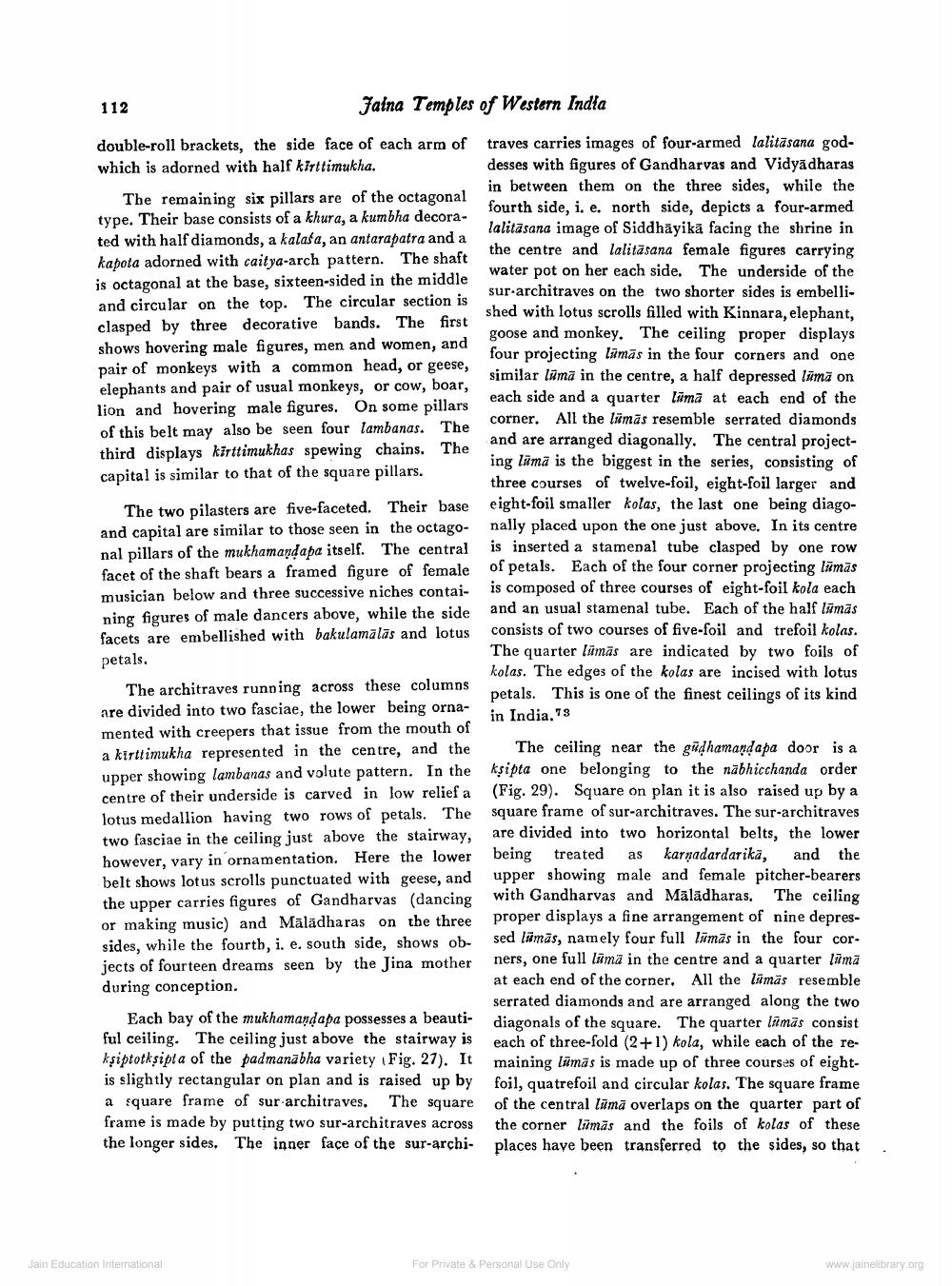________________
112
Jalna Temples of Western India
double-roll brackets, the side face of each arm of traves carries images of four-armed lalitasana godwhich is adorned with half kirttimukha.
desses with figures of Gandharvas and Vidyadharas
in between them on the three sides, while the The remaining six pillars are of the octagonal
fourth side, i. e. north side, depicts a four-armed type. Their base consists of a khura, a kumbha decorated with half diamonds, a kalaša, an antarapatra and a
lalitasana image of Siddhāyikā facing the shrine in
the centre and lalitasana female figures carrying kapota adorned with caitya-arch pattern. The shaft
water pot on her each side. is octagonal at the base, sixteen-sided in the middle
The underside of the
sur-architraves on the two shorter sides is embelliand circular on the top. The circular section is
shed with lotus scrolls filled with Kinnara, elephant, clasped by three decorative bands. The first
goose and monkey. The ceiling proper displays shows hovering male figures, men and women, and
four projecting lamās in the four corners and one pair of monkeys with a common head, or geese,
similar lüma in the centre, a half depressed lūmä on elephants and pair of usual monkeys, or cow, boar,
each side and a quarter Lama at each end of the lion and hovering male figures. On some pillars
corner. All the lümās resemble serrated diamonds of this belt may also be seen four lambanas. The
and are arranged diagonally. The central projectthird displays kirttimukhas spewing chains. The
ing lima is the biggest in the series, consisting of capital is similar to that of the square pillars.
three courses of twelve-foil, eight-foil larger and The two pilasters are five-faceted. Their base eight-foil smaller kolas, the last one being diagoand capital are similar to those seen in the octago- nally placed upon the one just above. In its centre nal pillars of the mukhamandapa itself. The central is inserted a stamenal tube clasped by one row facet of the shaft bears a framed figure of female of petals. Each of the four corner projecting lamās musician below and three successive niches contai- is composed of three courses of eight-foil kola each ning figures of male dancers above, while the side and an usual stamenal tube. Each of the half limās facets are embellished with bakulamālās and lotus consists of two courses of five-foil and trefoil kolas. petals.
The quarter lümās are indicated by two foils of
kolas. The edges of the kolas are incised with lotus The architraves running across these columns
petals. This is one of the finest ceilings of its kind are divided into two fasciae, the lower being orna
in India. mented with creepers that issue from the mouth of a kirttimukha represented in the centre, and the The ceiling near the gūdhamandapa door is a upper showing lambanas and volute pattern. In the kşipta one belonging to the näbhicchanda order centre of their underside is carved in low relief a (Fig. 29). Square on plan it is also raised up by a lotus medallion having two rows of petals. The square frame of sur-architraves. The sur-architraves two fasciae in the ceiling just above the stairway, are divided into two horizontal belts, the lower however, vary in ornamentation. Here the lower being treated as karnadardarikā, and the belt shows lotus scrolls punctuated with geese, and upper showing male and female pitcher-bearers the upper carries figures of Gandharvas (dancing with Gandharvas and Mälādharas. The ceiling or making music) and Mälädharas on the three proper displays a fine arrangement of nine depressides, while the fourth, i. e. south side, shows ob- sed lāmās, namely four full lämās in the four corjects of fourteen dreams seen by the Jina mother ners, one full lūma in the centre and a quarter lima during conception.
at each end of the corner. All the limäs resemble
serrated diamonds and are arranged along the two Each bay of the mukhamandapa possesses a beauti- diagonals of the square. The quarter lamäs consist ful ceiling. The ceiling just above the stairway is each of three-fold (2+1) kola, while each of the reksiptotksipta of the padmanabha variety Fig. 27). It maining lämās is made up of three courses of eightis slightly rectangular on plan and is raised up by foil, quatrefoil and circular kolas. The square frame a square frame of sur-architraves. The square of the central lāmā overlaps on the quarter part of frame is made by putting two sur-architraves across the corner limās and the foils of kolas of these the longer sides. The inner face of the sur-archi- places have been transferred to the sides, so that
Jain Education Interational
For Private & Personal Use Only
www.jainelibrary.org




